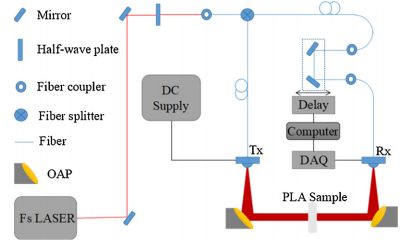 |
| (a) Segments of the hollow waveguide; (b) experimental results of the loss coefficient; (c) mechanical spliced 90 cm hollow waveguide. |
The terahertz (THz) wave is the electromagnetic radiation at frequencies from 0.1 to 10 THz, which is located between the millimeter wave and the far infrared wave. It has not been fully studied because of a lack of effective means of generation, detection and transmission, so it is referred to as the “Terahertz Gap.” The terahertz wave has a lot of potential in non-destructive imaging, biomedicine and national security and defense, because it has penetrability for most of non-polar materials and does not cause ionization damage while covering the vibration and rotational energy levels of biological macromolecules.
In a paper entitled “A 0.1 THz low-loss 3D printed hollow waveguide,” a group of researchers discusses the use of 3D printing to create THz functional devices, such as terahertz lenses, phase plates, waveguides and more. 3D printing is a low-cost, simple and effective way to create these devices, they point out.
“Therefore, the combination of low-loss dielectric waveguide and low-cost 3D printing will help to break through the bottlenecks and realize THz remote applications,” the researchers state. “The paper focuses on the design, fabrication, and characterization of a novel 0.1 THz low-loss hollow waveguide. Its theoretical loss is as low as 0.009 cm−1 and the measured loss is 0.015 cm−1. The experimental results show that the proposed hollow waveguide not only reduces the transmission loss of the terahertz wave, but also can effectively localize the terahertz field and confine the divergence angle of the terahertz beam.”
The researchers used PLA to create the hollow waveguide. First they needed to 3D print a PLA disk in order to obtain the elecrtromagnetic parameters of the material. The disk was printed on an Ultimaker 3D printer and characterized by terahertz time-domain spectroscopy (THz-TDS).
“After that the design for the hollow waveguide could be started,” the researchers continue. The first step is designing the cross section of the waveguide based on the anti-resonant waveguide model and drawing the cross section’s two-dimensional graph. Secondly, the graph is imported into the finite element simulation software (Comsol Multiphysics) and a larger circle around the cross section is drawn as the perfect matching layer. Thirdly, the different materials and the corresponding refractive index are selected and the design model is meshed. Finally, according to the simulation, the effective refractive index of different modes transmitted in the center air hole of the hollow waveguide can be acquired.”
The 90-cm-long hollow waveguide was then 3D printed and characterized. To verify the localization effect of the hollow waveguide on THz wave, the researchers measured the THz divergence angle at the end of the waveguide. The measured loss was 0.015 cm−1. The experimental results showed that the hollow waveguide can not only reduce the transmission loss of the terahertz wave in the air, but also effectively localize the terahertz wave. The researchers conclude that remote low-cost THz sensing and imaging can be achieved in the future by the development of flexible and longer hollow waveguides.
Authors of the paper include Pengfei Qi, Weiwei Liu and Cheng Gong.



No comments:
Post a Comment